| < Day Day Up > |
The convex hull of a set Q of points is the smallest convex polygon P for which each point in Q is either on the boundary of P or in its interior. (See Exercise 33.1-5 for a precise definition of a convex polygon.) We denote the convex hull of Q by CH(Q). Intuitively, we can think of each point in Q as being a nail sticking out from a board. The convex hull is then the shape formed by a tight rubber band that surrounds all the nails. Figure 33.6 shows a set of points and its convex hull.
In this section, we shall present two algorithms that compute the convex hull of a set of n points. Both algorithms output the vertices of the convex hull in counterclockwise order. The first, known as Graham's scan, runs in O(n lg n) time. The second, called Jarvis's march, runs in O(nh) time, where h is the number of vertices of the convex hull. As can be seen from Figure 33.6, every vertex of CH(Q) is a point in Q. Both algorithms exploit this property, deciding which vertices in Q to keep as vertices of the convex hull and which vertices in Q to throw out.
There are, in fact, several methods that compute convex hulls in O(n lg n) time. Both Graham's scan and Jarvis's march use a technique called "rotational sweep," processing vertices in the order of the polar angles they form with a reference vertex. Other methods include the following.
In the incremental method, the points are sorted from left to right, yielding a sequence 〈p1, p2, ..., pn〉. At the ith stage, the convex hull of the i - 1 leftmost points, CH({p1, p2, ..., pi-1}), is updated according to the ith point from the left, thus forming CH({p1, p2, ..., pi}). As Exercise 33.3-6 asks you to show, this method can be implemented to take a total of O(n lg n) time.
In the divide-and-conquer method, in Θ(n) time the set of n points is divided into two subsets, one containing the leftmost ⌈n/2⌉ points and one containing the rightmost ⌊n/2⌋ points, the convex hulls of the subsets are computed recursively, and then a clever method is used to combine the hulls in O(n) time. The running time is described by the familiar recurrence T(n) = 2T(n/2) + O(n), and so the divide-and-conquer method runs in O(n lg n) time.
The prune-and-search method is similar to the worst-case linear-time median algorithm of Section 9.3. It finds the upper portion (or "upper chain") of the convex hull by repeatedly throwing out a constant fraction of the remaining points until only the upper chain of the convex hull remains. It then does the same for the lower chain. This method is asymptotically the fastest: if the convex hull contains h vertices, it runs in only O(n lg h) time.
Computing the convex hull of a set of points is an interesting problem in its own right. Moreover, algorithms for some other computational-geometry problems start by computing a convex hull. Consider, for example, the two-dimensional farthest-pair problem: we are given a set of n points in the plane and wish to find the two points whose distance from each other is maximum. As Exercise 33.3-3 asks you to prove, these two points must be vertices of the convex hull. Although we won't prove it here, the farthest pair of vertices of an n-vertex convex polygon can be found in O(n) time. Thus, by computing the convex hull of the n input points in O(n lg n) time and then finding the farthest pair of the resulting convex-polygon vertices, we can find the farthest pair of points in any set of n points in O(n lg n) time.
Graham's scan solves the convex-hull problem by maintaining a stack S of candidate points. Each point of the input set Q is pushed once onto the stack, and the points that are not vertices of CH(Q) are eventually popped from the stack. When the algorithm terminates, stack S contains exactly the vertices of CH(Q), in counterclockwise order of their appearance on the boundary.
The procedure GRAHAM-SCAN takes as input a set Q of points, where |Q| ≥ 3. It calls the functions TOP(S), which returns the point on top of stack S without changing S, and NEXT-TO-TOP(S), which returns the point one entry below the top of stack S without changing S. As we shall prove in a moment, the stack S returned by GRAHAM-SCAN contains, from bottom to top, exactly the vertices of CH(Q) in counterclockwise order.
GRAHAM-SCAN(Q)
1 let p0 be the point in Q with the minimum y-coordinate,
or the leftmost such point in case of a tie
2 let 〈p1, p2, ..., pm〉 be the remaining points in Q,
sorted by polar angle in counterclockwise order around p0
(if more than one point has the same angle, remove all but
the one that is farthest from p0)
3 PUSH(p0, S)
4 PUSH(p1, S)
5 PUSH(p2, S)
6 for i ← 3 to m
7 do while the angle formed by points NEXT-TO-TOP(S), TOP(S),
and pi makes a nonleft turn
8 do POP(S)
9 PUSH(pi, S)
10 return S
Figure 33.7 illustrates the progress of GRAHAM-SCAN. Line 1 chooses point p0 as the point with the lowest y-coordinate, picking the leftmost such point in case of a tie. Since there is no point in Q that is below p0 and any other points with the same y-coordinate are to its right, p0 is a vertex of CH(Q). Line 2 sorts the remaining points of Q by polar angle relative to p0, using the same method-comparing cross products-as in Exercise 33.1-3. If two or more points have the same polar angle relative to p0, all but the farthest such point are convex combinations of p0 and the farthest point, and so we remove them entirely from consideration. We let m denote the number of points other than p0 that remain. The polar angle, measured in radians, of each point in Q relative to p0 is in the half-open interval [0, π). Since the points are sorted according to polar angles, they are sorted in counterclockwise order relative to p0. We designate this sorted sequence of points by 〈p1, p2, ..., pm〉. Note that points p1 and pm are vertices of CH(Q) (see Exercise 33.3-1). Figure 33.7(a) shows the points of Figure 33.6 sequentially numbered in order of increasing polar angle relative to p0.
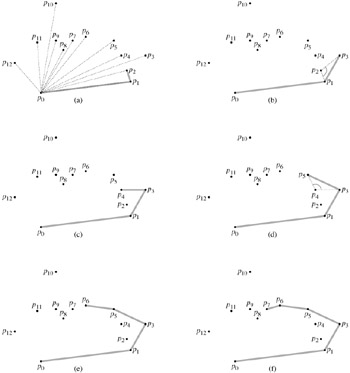
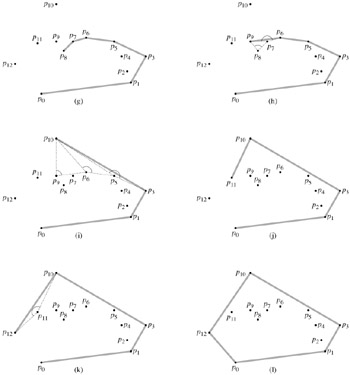
The remainder of the procedure uses the stack S. Lines 3-5 initialize the stack to contain, from bottom to top, the first three points p0, p1, and p2. Figure 33.7(a) shows the initial stack S. The for loop of lines 6-9 iterates once for each point in the subsequence 〈p3, p4, ..., pm〉. The intent is that after processing point pi , stack S contains, from bottom to top, the vertices of CH({ p0, p1, ..., pi}) in counterclockwise order. The while loop of lines 7-8 removes points from the stack if they are found not to be vertices of the convex hull. When we traverse the convex hull counterclockwise, we should make a left turn at each vertex. Thus, each time the while loop finds a vertex at which we make a nonleft turn, the vertex is popped from the stack. (By checking for a nonleft turn, rather than just a right turn, this test precludes the possibility of a straight angle at a vertex of the resulting convex hull. We want no straight angles, since no vertex of a convex polygon may be a convex combination of other vertices of the polygon.) After we pop all vertices that have nonleft turns when heading toward point pi , we push pi onto the stack. Figures 33.7(b)-(k) show the state of the stack S after each iteration of the for loop. Finally, GRAHAM-SCAN returns the stack S in line 10. Figure 33.7(l) shows the corresponding convex hull.
The following theorem formally proves the correctness of GRAHAM-SCAN.
If GRAHAM-SCAN is run on a set Q of points, where |Q| ≥ 3, then at termination, the stack S consists of, from bottom to top, exactly the vertices of CH(Q) in counterclockwise order.
Proof After line 2, we have the sequence of points 〈p1, p2, ..., pm〉. Let us define, for i = 2, 3, ..., m, the subset of points Qi = {p0, p1, ..., pi}. The points in Q - Qm are those that were removed because they had the same polar angle relative to p0 as some point in Qm; these points are not in CH(Q), and so CH(Qm) = CH(Q). Thus, it suffices to show that when GRAHAM-SCAN terminates, the stack S consists of the vertices of CH(Qm) in counterclockwise order from bottom to top. Note that just as p0, p1, and pm are vertices of CH(Q), the points p0, p1, and pi are all vertices of CH(Qi).
The proof uses the following loop invariant:
At the start of each iteration of the for loop of lines 6-9, stack S consists of, from bottom to top, exactly the vertices of CH(Qi-1) in counterclockwise order.
Initialization: The invariant holds the first time we execute line 6, since at that time, stack S consists of exactly the vertices of Q2 = Qi-1, and this set of three vertices forms its own convex hull. Moreover, they appear in counterclockwise order from bottom to top.
Maintenance: Entering an iteration of the for loop, the top point on stack S is pi-1, which was pushed at the end of the previous iteration (or before the first iteration, when i = 3). Let pj be the top point on S after the while loop of lines 7-8 is executed but before line 9 pushes pi, and let pk be the point just below pj on S. At the moment that pj is the top point on S and we have not yet pushed pi, stack S contains exactly the same points it contained after iteration j of the for loop. By the loop invariant, therefore, S contains exactly the vertices of CH(Qj) at that moment, and they appear in counterclockwise order from bottom to top.
Let us continue to focus on this moment just before pi is pushed. Referring to Figure 33.8(a), because pi's polar angle relative to p0 is greater than pj's polar angle, and because the angle ∠pkpjpi makes a left turn (otherwise we would have popped pj ), we see that since S contains exactly the vertices of CH(Qj), once we push pi , stack S will contain exactly the vertices of CH(Qj ∪ {pi}), still in counterclockwise order from bottom to top.
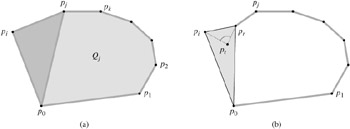
Figure 33.8: The proof of correctness of GRAHAM-SCAN. (a) Because pi's polar angle relative to p0 is greater than pj's polar angle, and because the angle ∠pkpj pi makes a left turn, adding pi to CH(Qj) gives exactly the vertices of CH(Qj ∪{pi}). (b) If the angle ∠prptpi makes a nonleft turn, then pt is either in the interior of the triangle formed by p0, pr, and pi or on a side of the triangle, and it cannot be a vertex of CH(Qi).
We now show that CH(Qj ∪ {pi}) is the same set of points as CH(Qi). Consider any point pt that was popped during iteration i of the for loop, and let pr be the point just below pt on stack S at the time pt was popped (pr might be pj ). The angle ∠prptpi makes a nonleft turn, and the polar angle of pt relative to p0 is greater than the polar angle of pr. As Figure 33.8(b) shows, pt must be either in the interior of the triangle formed by p0, pr, and pi or on a side of this triangle (but it is not a vertex of the triangle). Clearly, since pt is within a triangle formed by three other points of Qi, it cannot be a vertex of CH(Qi). Since pt is not a vertex of CH(Qi), we have that
Let Pi be the set of points that were popped during iteration i of the for loop. Since the equality (33.1) applies for all points in Pi, we can apply it repeatedly to show that CH(Qi - Pi) = CH(Qi). But Qi - Pi = Qj ∪ {pi}, and so we conclude that CH(Qj ∪ {pi}) = CH(Qi - Pi) = CH(Qi).
We have shown that once we push pi , stack S contains exactly the vertices of CH(Qi) in counterclockwise order from bottom to top. Incrementing i will then cause the loop invariant to hold for the next iteration.
Termination: When the loop terminates, we have i = m + 1, and so the loop invariant implies that stack S consists of exactly the vertices of CH(Qm), which is CH(Q), in counterclockwise order from bottom to top. This completes the proof.
We now show that the running time of GRAHAM-SCAN is O(n lg n), where n = |Q|. Line 1 takes Θ(n) time. Line 2 takes O(n lg n) time, using merge sort or heapsort to sort the polar angles and the cross-product method of Section 33.1 to compare angles. (Removing all but the farthest point with the same polar angle can be done in a total of O(n) time.) Lines 3-5 take O(1) time. Because m ≤ n - 1, the for loop of lines 6-9 is executed at most n - 3 times. Since PUSH takes O(1) time, each iteration takes O(1) time exclusive of the time spent in the while loop of lines 7-8, and thus overall the for loop takes O(n) time exclusive of the nested while loop.
We use aggregate analysis to show that the while loop takes O(n) time overall. For i = 0, 1, ..., m, each point pi is pushed onto stack S exactly once. As in the analysis of the MULTIPOP procedure of Section 17.1, we observe that there is at most one POP operation for each PUSH operation. At least three points-p0, p1, and pm-are never popped from the stack, so that in fact at most m - 2 POP operations are performed in total. Each iteration of the while loop performs one POP, and so there are at most m - 2 iterations of the while loop altogether. Since the test in line 7 takes O(1) time, each call of POP takes O(1) time, and since m ≤ n - 1, the total time taken by the while loop is O(n). Thus, the running time of GRAHAM-SCAN is O(n lg n).
Jarvis's march computes the convex hull of a set Q of points by a technique known as package wrapping (or gift wrapping). The algorithm runs in time O(nh), where h is the number of vertices of CH(Q). When h is o(lg n), Jarvis's march is asymptotically faster than Graham's scan.
Intuitively, Jarvis's march simulates wrapping a taut piece of paper around the set Q. We start by taping the end of the paper to the lowest point in the set, that is, to the same point p0 with which we start Graham's scan. This point is a vertex of the convex hull. We pull the paper to the right to make it taut, and then we pull it higher until it touches a point. This point must also be a vertex of the convex hull. Keeping the paper taut, we continue in this way around the set of vertices until we come back to our original point p0.
More formally, Jarvis's march builds a sequence H = 〈p0, p1, ..., ph-1〉 of the vertices of CH(Q). We start with p0. As Figure 33.9 shows, the next convex hull vertex p1 has the smallest polar angle with respect to p0. (In case of ties, we choose the point farthest from p0.) Similarly, p2 has the smallest polar angle with respect to p1, and so on. When we reach the highest vertex, say pk (breaking ties by choosing the farthest such vertex), we have constructed, as Figure 33.9 shows, the right chain of CH(Q). To construct the left chain, we start at pk and choose pk+1 as the point with the smallest polar angle with respect to pk, but from the negative x-axis. We continue on, forming the left chain by taking polar angles from the negative x-axis, until we come back to our original vertex p0.
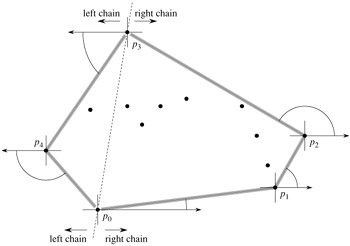
We could implement Jarvis's march in one conceptual sweep around the convex hull, that is, without separately constructing the right and left chains. Such implementations typically keep track of the angle of the last convex-hull side chosen and require the sequence of angles of hull sides to be strictly increasing (in the range of 0 to 2π radians). The advantage of constructing separate chains is that we need not explicitly compute angles; the techniques of Section 33.1 suffice to compare angles.
If implemented properly, Jarvis's march has a running time of O(nh). For each of the h vertices of CH(Q), we find the vertex with the minimum polar angle. Each comparison between polar angles takes O(1) time, using the techniques of Section 33.1. As Section 9.1 shows, we can compute the minimum of n values in O(n) time if each comparison takes O(1) time. Thus, Jarvis's march takes O(nh) time.
Prove that in the procedure GRAHAM-SCAN, points p1 and pm must be vertices of CH(Q).
Consider a model of computation that supports addition, comparison, and multiplication and for which there is a lower bound of Ω(n lg n) to sort n numbers. Prove that Ω(n lg n) is a lower bound for computing, in order, the vertices of the convex hull of a set of n points in such a model.
Given a set of points Q, prove that the pair of points farthest from each other must be vertices of CH(Q).
For a given polygon P and a point q on its boundary, the shadow of q is the set of points r such that the segment ![]() is entirely on the boundary or in the interior of P.
is entirely on the boundary or in the interior of P.
A polygon P is star-shaped if there exists a point p in the interior of P that is in the shadow of every point on the boundary of P. The set of all such points p is called the kernel of P. (See Figure 33.10.) Given an n-vertex, star-shaped polygon P specified by its vertices in counterclockwise order, show how to compute CH(P) in O(n) time.
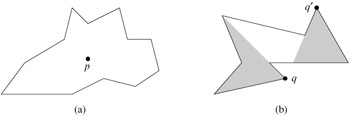
In the on-line convex-hull problem, we are given the set Q of n points one point at a time. After receiving each point, we are to compute the convex hull of the points seen so far. Obviously, we could run Graham's scan once for each point, with a total running time of O(n2 lg n). Show how to solve the on-line convex-hull problem in a total of O(n2) time.
| < Day Day Up > |